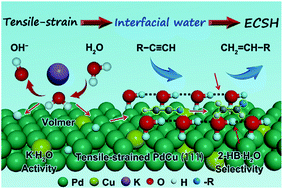Regulating the interfacial water structure by tensile strain to boost electrochemical semi-hydrogenation of alkynes†
Abstract
Electrochemical semi-hydrogenation (ECSH) of alkynes to produce alkenes is an ideal alternative to traditional thermal semi-hydrogenation (TSH) and yet is limited by low conversion yield and product selectivity. Here, we report a new strategy to tune the activity and selectivity of ECSH by regulating the interfacial water structure. The obtained PdCu icosahedrons deliver a greatly enhanced conversion rate and 98.5% alkene selectivity at 96.5% conversion, as well as sustaining about 100 h continuous test. Tensile strain originating from an icosahedral twinned structure is proved to facilitate the formation of an interfacial water structure, especially K+ ion hydrated water (K·H2O) and 2-coordinated hydrogen-bonded water (2-HB·H2O). We also decode the mysterious role of an interfacial water structure in ECSH performance, in which K·H2O speeds up water splitting to produce Hads which in turn accelerates ECSH conversion, and 2-HB·H2O improves alkene selectivity. The findings provide insights into the tuning of the interfacial water structure in electrocatalyst design in proton-coupled hydrogenation from the viewpoint of lattice strain.

- This article is part of the themed collection: 2022 Inorganic Chemistry Frontiers HOT articles


 Please wait while we load your content...
Please wait while we load your content...